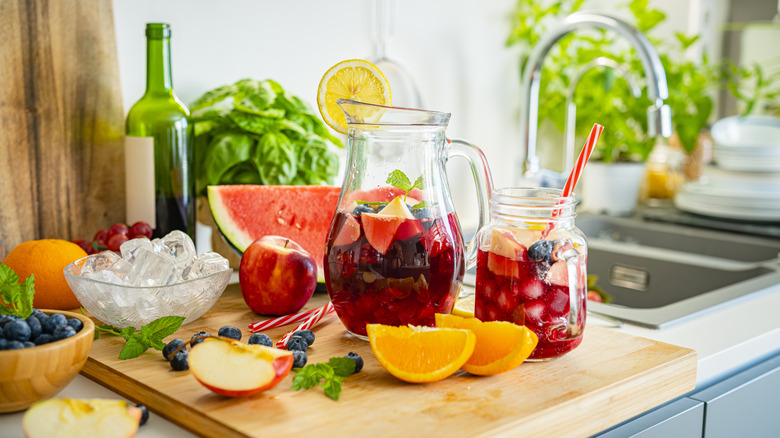Sangria Is The Best Way To Transform Your Leftover Wine
It's happened to most of us: You popped open one-too-many bottles of wine while hosting a party or used a few glugs in a recipe and now have too much to down yourself. Those bottles inevitably end up languishing in the fridge, only to have their contents poured down the drain once you remember them. But there's an easy way to salvage that leftover wine — give it new life as the base for a sangria, whose riot of sweet, fruity, and robust flavors will result in a vibrant drink. "Sangria is a great way to use your one- to two-day-old bottle of wine," Camille Goldstein, co-founder of mixology company Muddling Memories, tells Tasting Table.
As soon as a bottle of wine is opened, it is, of course, exposed to oxygen. Allowing certain varietals to breathe — typically for one to two hours — can be beneficial, softening tannins as well as deepening complex aromas and flavors. However, in just two full days, oxidation starts to flatten a wine's fruity tickle and morph its scent into something that's akin to vinegar. But that timeframe is exactly when aging wine still has time for a glow up as a primary ingredient in Spain's famous punch. "If your wine is about to oxidize and it's not so tasty as a glass on its own any longer, use it to make an epic sangria," says Goldstein. "You can add spices, sugars, fruits, and other spirits to transform your old wine into the best new sangria!"
Choose your own adventure
Start that process with a leftover bottle of a dry red for a classic rendition of the beverage, which also helps ensure that the batch doesn't come out too sweet. Spanish wines that utilize the tempranillo grape are traditional, but feel free to experiment with other styles. However, there are some varieties to avoid — for example, wines that are highly tannic or have a strong oaky backbone tend to overwhelm other flavors in the mixture.
Sangria is really more of a choose-your-own adventure kind of drink, so you can amp up the booze by adding more brandy, though you'll want at least ¼ of a cup. For a departure from the norm, sub in bourbon, especially if you plan on loading your pitcher with oranges and lemons. The spirit's smoky undertone pairs well with citrus.
Anywhere from 2 to 4 tablespoons of sugar should adequately sweeten the beverage (start on the lower end and taste as you add) along with a ½ cup of orange juice or a splash of orange liqueur. It's best to allow those flavors to fully blend together overnight in the fridge and then cut fresh fruit to dose the pitcher right before serving. Apples slices and orange wedges are the go-to, which also temper the red wine's richness, but if you prefer strawberries, lemons, or even lychee, treat it like an "everyone into the pool" event and clean out the fruit drawer in your fridge.

